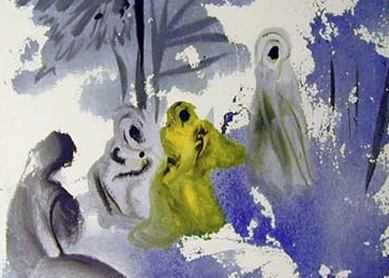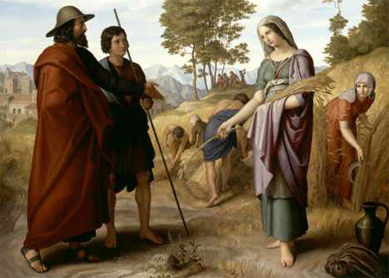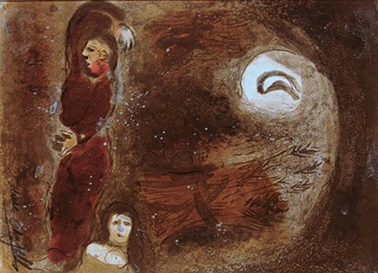Ruth is one of just two women in the Hebrew Bible (with Esther) to have a book named after her. The book of Ruth is a consummate example of a short story, with a small number of characters and a compact and fast-paced plot in which all loose ends are tied up within four short chapters. But it would be a mistake to think that the polished brevity of the book indicates a lack of mystery. There is plenty to ponder about the book of Ruth, but also about the character Ruth, starting with the question of whether or not Ruth should be considered the hero of her own book.
Is Ruth the hero of the book of Ruth?
The book of Ruth begins, as many biblical stories do, with the “name, rank, and serial number,” so to speak, of a particular man, in this case Elimelech. Biblical stories often focus on men, and this story at first seems no different, with its initial attention to Elimelech, “an Ephrathite from Bethlehem,” and his sons. Naomi is introduced as “his wife,” and Ruth is introduced almost as an afterthought, as the Moabite wife of one of the sons. At the end of the book we return to this focus on male descendants, as the story culminates in the birth of Ruth’s son Obed, “the father of Jesse, the father of David” (Ruth 4:17).
In other words, Ruth begins the book that bears her name as an afterthought and ends it by being written out of a list of male descendants—and in between she is given orders by Naomi (Ruth 3:1-5), and her fate is decided by the wealthy and powerful Boaz (Ruth 4:1-12).
Is Ruth, then, the hero of her own book? I think the answer is yes. For even though Ruth has no official power or authority in the book, she is the one who unofficially makes things happen. If the “hero” of any story is the person who acts decisively to resolve the central tension of the plot, then Ruth is our hero. The tension in the story revolves around the widowed Naomi’s lack of a male heir and therefore, in a society where women depend on male relations, her economic insecurity. Ruth, too, is a widow, but she is younger and therefore in less of a precarious situation. Ruth, through some very bold and even risky action, is (ultimately) able to provide the heir that both she and Naomi need in order to survive.
Just what happens on the threshing floor?
Our first clue to Ruth’s decisiveness and courage comes in Ruth 1:16-17, where she defies Naomi’s order to return to her own family after the death of Ruth’s husband (Naomi’s son), following Naomi to Israel and thus to an uncertain future. Then, in chapter 2, Ruth takes the initiative to go out during the harvest and find a field where she might glean some grain to feed herself and Naomi, an undertaking that clearly puts her (as a Moabite and a woman alone) at risk. But it is in chapter 3 that we see Ruth at her most bold, as she approaches Boaz, the owner of the field, who is sleeping on the threshing floor; in the dead of night, she daringly negotiates a more secure future for herself and Naomi.
Readers often wonder just what happens on the threshing floor where Ruth spends the night with Boaz. The story tells us that he has been drinking rather heavily and that Ruth uncovers his feet. As it happens, “feet” is sometimes a code word in the Hebrew Bible for a more private part of the body. But however one understands the word here, Boaz is clearly half-drunk and half-naked when he awakens to find Ruth lying next to him. Who is this woman, Boaz wonders? How far have things gone? With Boaz in a state of confused vulnerability, Ruth offers herself to him (“spread your cloak over your servant,” Ruth 3:9). She tells Boaz that he is the “next-of-kin”—the man in a position to redeem ownership of Elimelech’s property since there is no male heir (see the related law of the levirate in Deut 25:5-10). That is, Ruth sets things up so that if Boaz wants her then he must also help Naomi economically, thereby also giving Boaz a cloak of respectability with which to cover his romantic interest in this foreign woman, an interest suggested in Ruth 2:5 and confirmed in Ruth 3:10. Boaz, though vulnerable and confused during the nighttime meeting with Ruth, turns confident and effective in the daylight, as we see him publicly implement Ruth’s plan (Ruth 4:1-6).
In the face of Naomi’s passivity and Boaz’s confusion, Ruth provides for the “happily ever after” ending that has satisfied so many readers—she marries Boaz and produces a male heir. But is Ruth herself satisfied? Well, the one thing we know that Ruth desires is to stay with Naomi, and in the end she manages to pull that off.
Bibliography
- Fewell, Danna N., and David M. Gunn. Compromising Redemption: Relating Characters in the Book of Ruth. Louisville: Westminster John Knox, 1990.
- Koosed, Jennifer L. Gleaning Ruth: A Biblical Heroine and Her Afterlives. Columbia: University of South Carolina Press, 2011.
- Linafelt, Tod. Ruth. Collegeville, MN: Liturgical Press, 1999.





